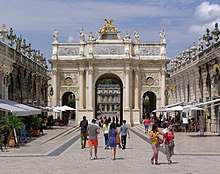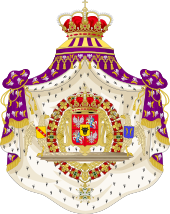Stanislaus I. Leszczyński

Stanisław I ( ) (actually Stanisław Bogusław Leszczyński * 20th October 1677 in Lvov , Poland-Lithuania ; † 23. February 1766 in Luneville , Duchy of Lorraine ) was a Polish aristocrat , magnate , officials in the civil service , Imperial Count in the Holy Roman Empire and statesman from the Leszczyńskis family .
Leszczyński was elected head of state as King of Poland and Grand Duke of Lithuania and from 1736 titular ruler of Poland-Lithuania in the course of the Great Northern War 1704–1709 and again in the power vacuum of the War of the Polish Succession from 1733–1736 .
The marriage of his daughter Maria Leszczyńska to the French King Louis XV. finally brought him in 1737 the duchies of Lorraine and Bar , which fell to the kingdom of France after his death .
Life
Stanislaus was born to Anna Leszczyńska, nee Jabłonowska and Count Rafał Leszczyński zu Lwów . Before he was elected king, he held various offices in the kingdom, from 1696 he was Starost of Odolanów , from 1697 grand cupid of the Kingdom of Poland and from 1699 voivode of Posen . The members of the Leszczyński family were also imperial counts in the Holy Roman Empire since 1473. He was a diplomat in the civil service of Kings Jan III. Sobieski and his successor August II. In 1698 Stanislaus married Countess Katharina Opalińska in Cracow . The daughter Anna , born in 1699, was followed by the birth of the second daughter Maria in 1703 .
The war against the Kingdom of Sweden , agreed in Moscow in 1699 between Tsar Peter I , King August II of Poland and Frederick IV of Denmark , developed differently than planned. Instead of the hoped-for territorial gains in the Baltic States , August II did not achieve any military successes against King Charles XII. of Sweden . On the contrary, since 1702, Polish territory had immediately become a deployment area and theater of war for Swedish troops.
After the victory of Krakow in 1702 and the conquest of Thorn by Charles XII. the military and economic position of August II was hopeless. Due to the devastating economic situation, the Polish nobility split into different camps. The Confederation of Warsaw pressed for an end to the war. Stanislaus Leszczyński joined her and from 1704 led the peace negotiations with Charles XII.
First reign
The trust of Charles XII. in Stanislaus Leszczyński was instrumental in helping with the election of King and Grand Duke. Stanislaus was able to assert himself against the French candidate François-Louis de Bourbon, Prince de Condé . Against the candidacy of the Polish magnate Jerzy Dominik Lubomirski and the Lithuanian prince Radziwiłł Stanislaus won the election on July 12, 1704 and was elected by supporters of the Warsaw Confederation. The supporters of the Sandomir Confederation stayed away from the election and refused to support Stanislaus I. Leszczyński . On October 4, 1705, the coronation celebrations took place in Warsaw .
The occupation of the Electorate of Saxony and the impending bankruptcy prompted the Privy Council, influenced by the estates, to sign the peace treaty with Sweden, the Altranstadt Peace , on October 13, 1706 . On December 31, 1706, August II signed the treaty that had been resolved in his absence, thereby renouncing the Polish-Lithuanian crown.
The political fate of Stanislaus I was closely related to that of Charles XII. bound. In the battle of Poltava the Russian troops defeated the Swedish army. Karl and his remaining troops sought refuge with Sultan Ahmed III. in the Ottoman Empire . Immediately afterwards August II announced the terms of the Altranstadt Peace. In 1709 he was declared legitimate king by a large part of the Polish nobility.
First exile
Stanislaus I. Leszczyński fled via Stettin and Stralsund to Kristianstad and Stockholm with only a few supporters of his own and a small number of Swedish troops . The request for approval of the abdication as Polish king was made to Stanislaus I by Charles XII. denied. This hoped for the military help of Ahmed III. This meant that Stanislaus, who like many of his supporters had lost his property, could not return to Poland. Stanislaus I followed Charles XII. after Bender and received from him as a temporary solution until the recovery of Poland, asylum in the Swedish ruled Duchy of Palatinate-Zweibrücken , where he was allowed to maintain his own court in Zweibrücken . However, this soon overstretched the financial strength of the territory. The Tschifflick pleasure palace still gives evidence of this today . His eldest daughter Anna Leszczyńska died here .
After the death of Charles XII. In 1718 Stanislaus had to leave the duchy and asked Duke Leopold of Lorraine for refuge. In order to protect himself from the attacks on himself by August II, he and his family went to the safety of the French garrison towns of Landau and Weissenburg in Alsace .
On the mediation of Jeanne-Agnès Berthelot de Pléneuf , the marriage of the daughter Maria Leszczyńska with Louis XV was after 1723 . prepared and carried out on September 5, 1725 in Fontainebleau . In 1725 Stanislaus moved to Chambord with his wife .
Second reign
In the War of the Polish Succession (1733-1735 / 1738) King Louis XV supported. Stanislaus Leszczyński's efforts to regain the Polish crown. After the death of August II, Stanislaus returned to Poland from exile in France and was elected a second time as King and Grand Duke on September 11, 1733 with a clear majority of the electors . However, he was supported by a military coalition of Austria , Russia and Electoral Saxony, as well as part of the Polish nobility, who voted for August III. and its coronation on January 17, 1734 supported, overthrown and disempowered.
In the Vienna Preliminary Peace between France and the House of Austria concluded in Vienna on October 3, 1735 , France recognized the Saxon Elector as King of Poland. The contract was until May 1, 1737 in the definitive peace also from Poland, Russia, Spain and Sardinia-Piedmont signed. On November 18, 1738 came the publication of the Treaty of Vienna and the confirmation of the peace preliminaries of the 1735th
Second exile

Stanislaus first fled to Danzig and then found refuge in 1734 with the Prussian King Friedrich Wilhelm I in Königsberg . France gave up military intervention and reached an agreement with the House of Austria in the Vienna Preliminary Peace of 1735.
One result of the contract negotiations was the exchange of the Duchies of Bar and Lorraine for the Grand Duchy of Tuscany after the death of the last Grand Duke Gian Gastone de 'Medici .
In 1736 Stanislaus was installed in the Duchy of Bar. After the death of Gian Gastone de 'Medici, Lorraine was also transferred to France, whereupon Stanislaus moved his residence to the castles of Commercy and Lunéville . A French Intendant de Justice, Police et Finances , based in Nancy, was appointed to administer the duchies and prepared the agreed incorporation after Stanislaus' death. As a pension, Stanislaus received two million livres a year . In the years that followed, an important cultural life developed at the court of Stanislaus in Lunéville.
In 1747 his wife Katharina died in Lunéville at the age of 66. Stanislaus Leszczyński died in tragic circumstances. On February 5, 1766, his clothes caught fire in the fireplace and he was badly burned. After several weeks of trying to alleviate his torment, he died on February 23 at the age of 88 at Lunéville Castle . Like Katharina, Stanislaus was buried in 1766 in the Notre-Dame-de-Bonsecours church in Nancy, built by Emmanuel Héré . Both duchies were immediately annexed to France. The king's remains were transferred to Poland in 1814. After several intermediate storage, they were not buried until 1938 in the Wawel Cathedral in Krakow .
children
- Anna Leszczyńska (1699–1717), Princess of Poland
- Maria Leszczyńska (1703–1768), Princess of Poland and from 1725 Queen of France
photos
Stanislaus I. Leszczyński as King of Poland with the sash of the Order of the White Eagle, painting by Jean-Baptiste van Loo
Stanislaus I. Leszczyński as King of Poland with the sash of the Order of the White Eagle, painting by Jean-Marc Nattier
Stanislaus Leszczyński as Duke of Lorraine and Bar, painting by Jean Girardet
Monument in Nancy for Duke Stanislaus Leszczyński
King Stanislaus I. Leszczyński in Sarmatian dress , painting by Jan Matejko
King Stanislaus I Leszczyński with his family during his first reign as King of Poland-Lithuania, painting by Johan David Swartz
Adaptations in literature and music
- Giuseppe Verdi's opera “ Un giorno di regno ” deals with Leszczyński's return to Poland in 1733. Carl Millöcker takes up the same theme with his operetta “ The Begging Student ”.
literature
- Campbell Thomas. 1842. Frederick the Great: His Court and Times, Friedrich, the Great King of Prussia Friedrich, Frederic Shoberl, Stanislaus Lesczinski.
- Luynes, Duc de . 1860-1865. Mémoires . Paris.
- Boyé, Pierre. 1898. La cour polonaise de Lunéville (1737–1766) . Nancy.
- Boyé. Pierre. 1910. Les châteaux du roi Stanislas en Lorraine . Nancy.
- Boyé, Pierre. 1939. The Chancelier Chaument de la Galaizière et sa famille . Nancy.
- Boyé, Pierre. 1939. Le mariage de Marie Leszcynska et l'europe , Nancy.
- Chapotot, Stephanie. 1999. Les jardins du roi Stanislas en Lorraine . Metz: Editions Serpenoise.
- Rau-von der Schulenburg, Julia. 1973. Emmanuel Héré, Stanislas Leszczynski's premier architecte in Lorraine . 1705-1763. Frankfurt research on the history of architecture. Vol. 4., Berlin.
Web links
- Publications on Stanislaus I. Leszczyński at LitDok East Central Europe / Herder Institute (Marburg)
Individual evidence
- ↑ As a starost, cupbearer and voivode.
| predecessor | Office | successor |
|---|---|---|
| August II |
King of Poland, Grand Duke of Lithuania 1704–1709 |
August II |
| August II |
King of Poland, Grand Duke of Lithuania 1733–1736 |
August III. |
| Francis III |
Duke of Lorraine and Bar 1737–1766 |
to France |
| personal data | |
|---|---|
| SURNAME | Leszczyński, Stanislaus I. |
| ALTERNATIVE NAMES | Leszczyński, Stanisław Bogusław (real name) |
| BRIEF DESCRIPTION | Polish aristocrat, magnate, civil servant, imperial count and statesman |
| DATE OF BIRTH | October 20, 1677 |
| PLACE OF BIRTH | Lviv , Galicia |
| DATE OF DEATH | February 23, 1766 |
| Place of death | Lunéville , Duchy of Lorraine , Holy Roman Empire |









